Expanding Utilization of Roots, Tubers and Bananas and Reducing Their Postharvest Losses (RTB-ENDURE) is a 3 year project (2014-2016) implemented by the CGIAR Research Program on Roots, Tubers and Bananas (RTB) with funding by the European Union and technical support of IFAD. http://www.rtb.cgiar.org/endure
IV. Sweetpotato as a livestock feed
CHALLENGES TO USE OF SWEETPOTATO RESIDUES AS LIVESTOCK FEED
Although sweetpotatoes are a good source of energy (roots) and protein (vines), they are highly perishable. In order to make good use of sweetpotato residues (vines and roots) there is need to conserve them in form of silage which has the potential to mitigate seasonal feed shortages and help cope with seasonal feed prices fluctuations that many smallholder livestock farmers experience. It also provides opportunity to reduce waste in urban market and at household level as well as it can open up business opportunities for youth and womenSweetpotato silage is a method for preserving vines and roots in a succulent condition in a silo. Well-made sweetpotato silage is a wholesome and nutritious feed for all classes of cattle and pigs. Sweetpotato silage is made by fermenting chopped vines and roots of non- commercial value in the absence of air and can be stored for up to a year. Its protein content and digestibility makes it an excellent complement to grass feeds (Table 2).
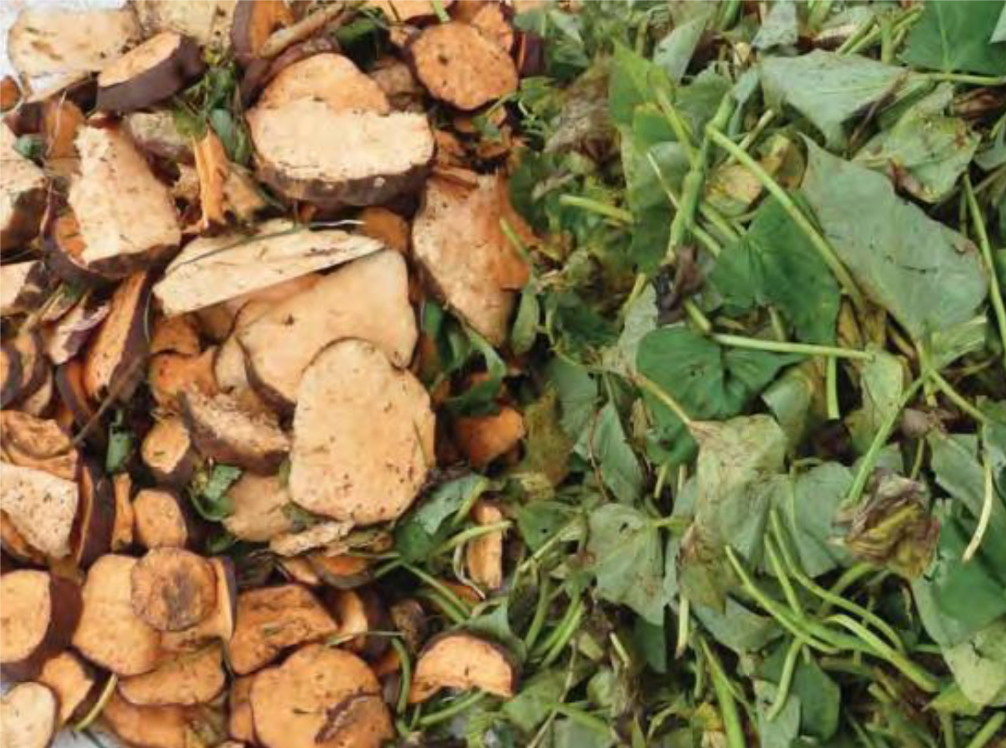
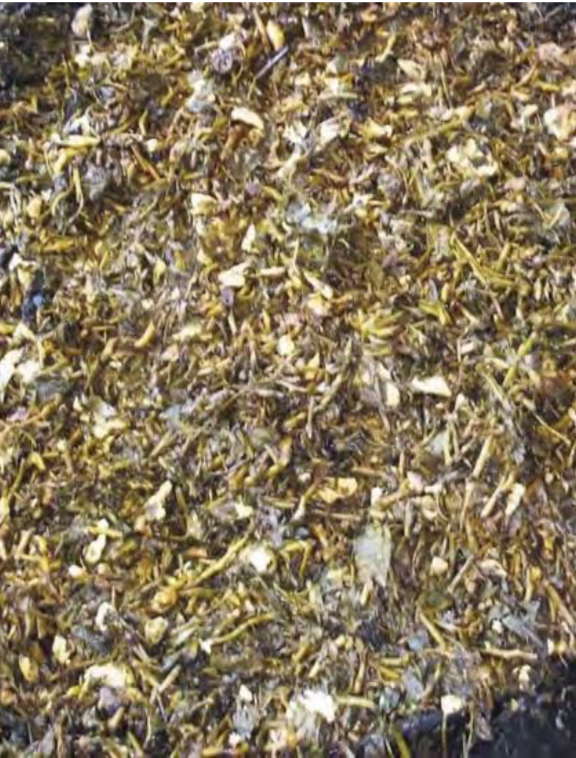
Nutrient value of sweetpotato vines and silage compared to Napier grass*
Product:Fresh S.Potato Vines
Moisture content %:87
Crude protein content %:16.0
Neutral Detergent Fibre %:46
Metabolizable energy MJ/kg:8.3
Digestibility %:60
Product:S.Potato Silage Vine and roots
Moisture content %:72
Crude protein content %:16.2
Neutral Detergent Fibre %:20
Metabolizable energy MJ/kg:13.3
Digestibility %:69
Product:Fresh Napier Grass
Moisture content %:82
Crude protein content %:10
Neutral Detergent Fibre %:60
Metabolizable energy MJ/kg:8.5
Digestibility %:60
Product:Napier Grass Silage
Moisture content %:80
Crude protein content %:9.5
Neutral Detergent Fibre %:56
Metabolizable energy MJ/kg:7.8
Digestibility %:66
*Values on dry matter basis at 6-8 weeks old
Silage can be made with only chopped vines or combined chopped vines with roots (at a ratio of 70:30) or with a grass like napier. The use of a ferment starter, like molasses, improves the process of fermentation and nutrient content. Use of sweetpotato silage can significantly reduce feeding costs. However, sweetpotato silage is underutilized in Sub- Saharan Africa because it is largely unknown. The best use of sweetpotato silage is during periods of feed scarcity. Vines and roots can be chopped either manually (panga) or with a motorized forage chopper. The former is recommend for small scale producers while a motorized chopper (costing about UGX 2 to 3 million depending on the capacity) is more suitable for large scale producers or farmers’ groups.
METHODS USED TO MAKE SILAGE: TYPES OF SILOS
(1) Stack silo
- A plastic sheet (about 0.1 mm thick) is spread over the ground.
- Material for making silage is chopped using a forage chopper or a panga and placedon the sheet or cemented floor (Figure 1).
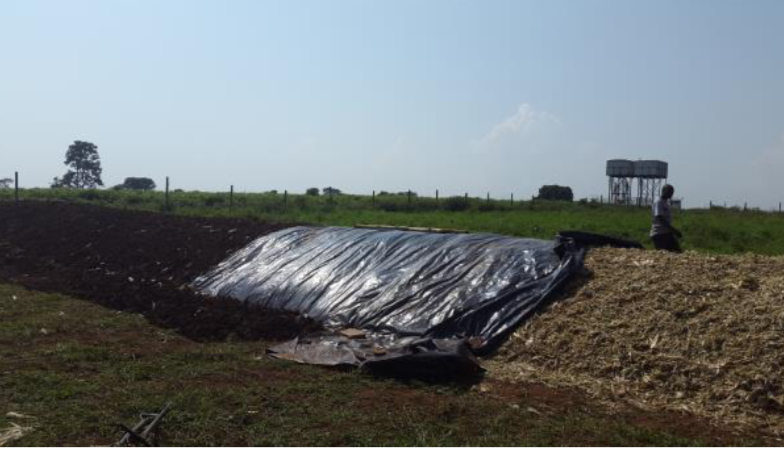
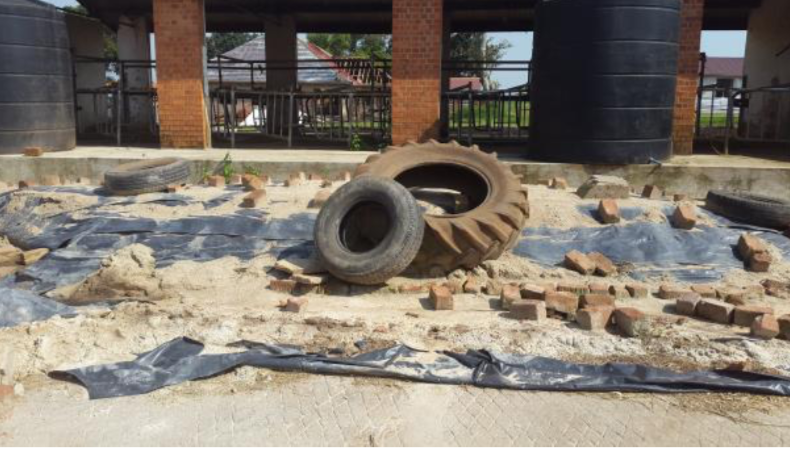
- The material is entirely covered with a plastic sheet.
- Proper tread pressure has to be applied, and complete sealing is required.
- The size of a silo depends on the number of raising animals.
- It is necessary to make steps to prevent damages on the plastic sheet by field miceor birds.Table 3 shows estimated cost of materials required to produce 500 kgs using stack silo method. The calculations are based on the assumption that the farmer gets the vines from her/his field.
Estimated cost of materials required to produce 500 kgs using stack silo method
| Material | Quantity | Unit cost (UGX) | Total (UGX) |
| Fuel and oil for forage chopper | 1 | 5,000 | 5,000 |
| Polythene material (meters) | 15 | 4,000 | 60,000 |
| Chopping and ensiling process (labour) | 2 | 20,000 | 40,000 |
| Mollasses (litres) | 16 | 2000 | 32,000 |
| Total | 137,000 |
Estimated cost of producing 1 kg of silage: UGX 274
(2) Trench silo
A trench silo can be built by simply digging the ground, but it is better to place plastic sheets inside to prevent loss (Figure 2).\
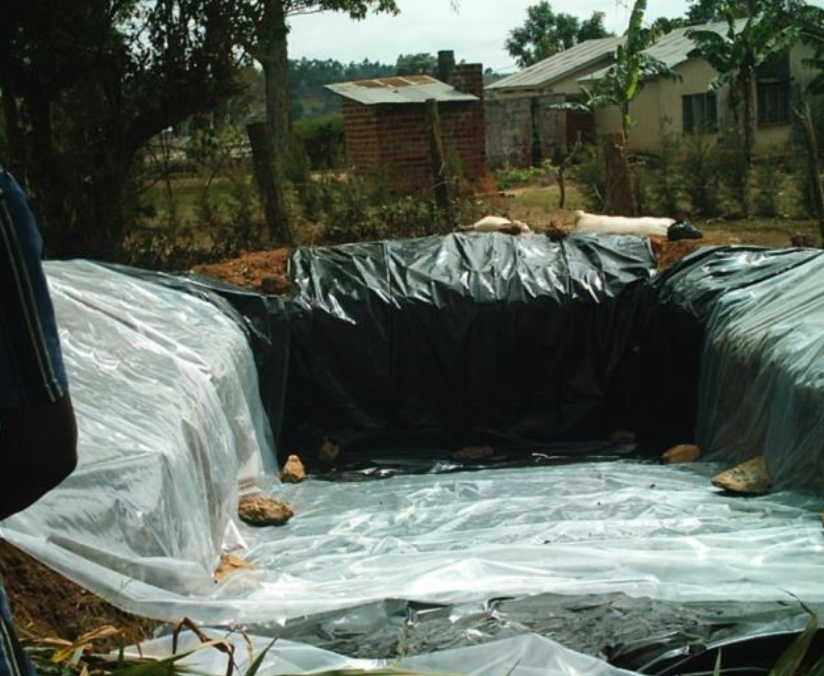
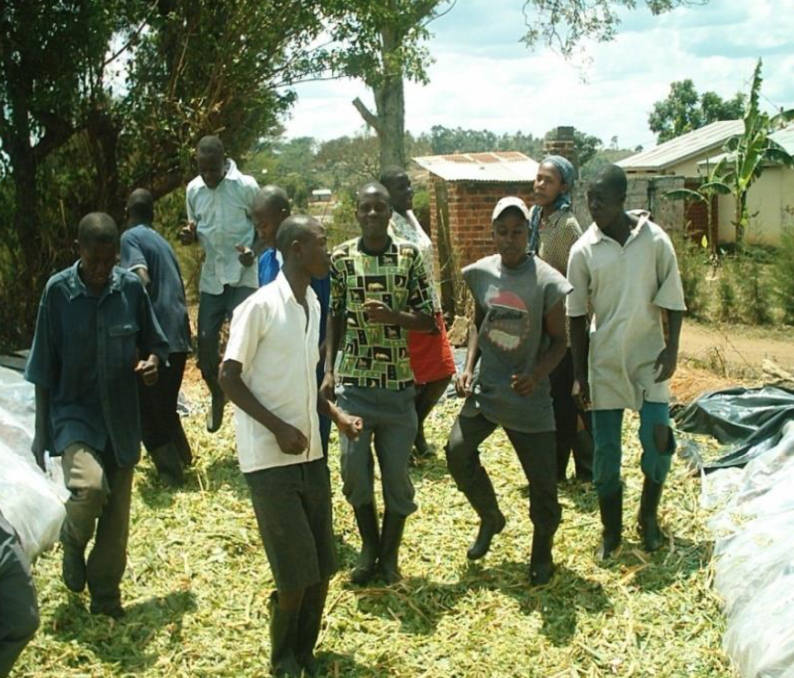
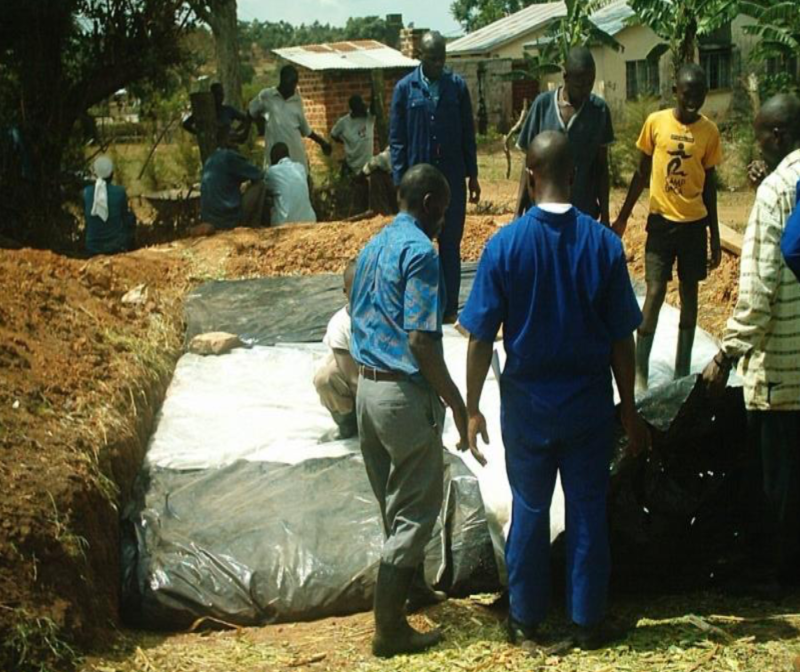
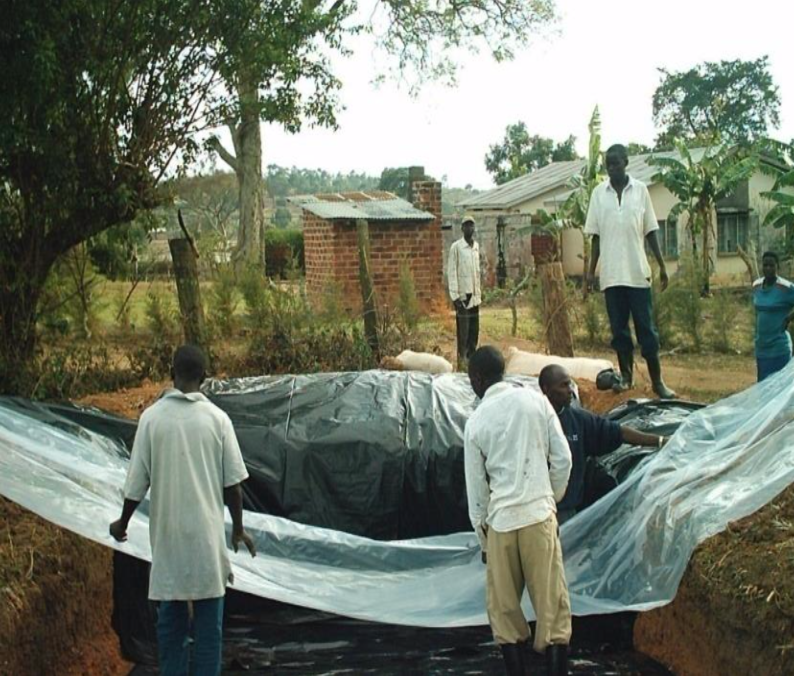
Figure 2: A trench silo
Proper tread pressure also has to be applied, and complete sealing is required.
Table 4 shows estimated cost of materials required to produce 500 kgs using trench silo method. The calculations are based on the assumption that the farmer gets the vines from her/his field.
| Material | Quant | Unit cost (UGX) | Total Cost (UGX) |
| Digging a pit | 1 | 20,000 | 20,000 |
| Fuel and oil for chopper | 1 | 5,000 | 5,000 |
| Polythene material (meters) | 25 | 4,000 | 100,000 |
| Chopping and ensiling process (labour) | 2 | 20,000 | 40,000 |
| Mollasses (litres) | 16 | 2000 | 32000 |
| Total | 197,000 |
Estimated cost of making 1 kg of silage: UGX 394
(3) Plastic bag silo
This is a plastic bag with the thickness of about 0.1 mm and silage materials are packed inside (Figure 3). Commercial imported plastic bags are available although they are very expensive. Plastic bags for fertilizer and feed may be reused for cost-cutting. There are many methods of making silage but use of plastic tubes is one of those suitable for smallholder dairy farmers
Advantages:
- Plastics silage bags are an economical alternative to traditional silage storage systems, such as pits and silos when related, harvest and storage losses are considered.
- It is an effective way for preserving feed with minimum nutrient loss (the anaerobic environment that is created eliminates spoilage from the growth of yeasts, moulds and adverse bacteria while maintaining essential proteins and nutrients).
- Allows farmers to store silage anywhere they need it. A well graded and well drained ground surface is all that is necessary.
- The silage is completely sealed in the bag. This means that all the acid is retained in the silage, unlike that in pit silage when it seeps out through the bottom of the pit as effluent. This compensates for the longer pieces of forage and poorer compaction than that found with silage machinery, so that the quality of the silage is just as good.
- Ensiling in a bag avoids the hard work of having to remove silage, as it has to be from a pit, when it has to be dug out every day.
- Because the whole bag is fed out to the animal, it means the rest of the silage which is in the other bags is not exposed to air at removal and is therefore unspoiled. Much of the silage in pits has been found to be spoiled due to poor sealing and exposure to air every day when the silage is removed for feeding.
- The bag is easily stored and easily portable so that any member of the family can carry it to the feed trough for the cow.
- Disadvantages:
- The importance of pest control to prevent damage on the bags,
- Containment and disposal of the plastic, once silage is removed from the bag,
- The need to chop the green mass, as chopped material tends to make much better silage, because more air can be squeezed out of it during the packing process, and the small pieces cannot puncture the bag
- Most losses of silage during the process occur due to:
- Unnoticed bird/rodent damage to the bags resulting in spoilage losses.
- Too wet (gaseous/seepage losses) or too dry (spoilage)
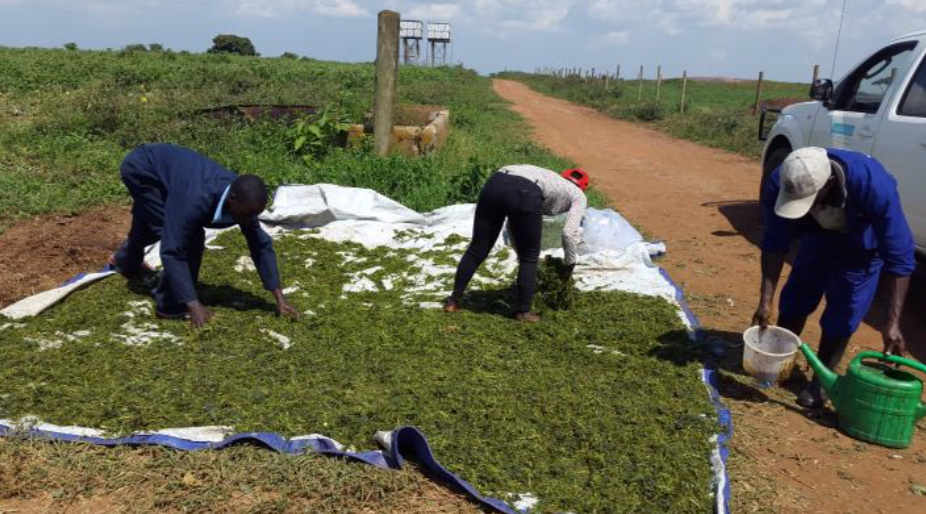

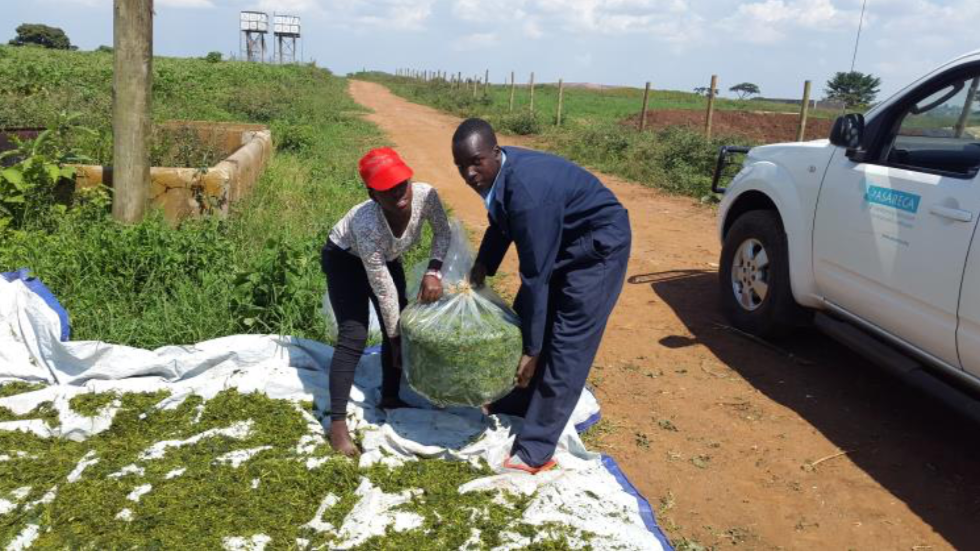
Table 5 shows estimated cost of materials required to produce 500 kgs using trench silo method. The calculations are based on the assumption that the farmer gets the vines from her/his field.
| Material | Quant | Unit cost (UGX) | Total (UGX) |
| Fuel and oil for chopper | 1 | 5,000 | 5,000 |
| Polythene material (meters) | 5 | 4,000 | 20,000 |
| Ensiling process (labour) | 2 | 20,000 | 40,000 |
| Sisal string (rolls) | 1 | 5,000 | 5,000 |
| Molasses (litres) | 16 | 2,000 | 32,000 |
| Total | 102,000 |
Bags must be packed with chopped raw materials, compressed as much as possible to remove the internal air and then sealed completely. The number of bags is determined freely in accordance with the operation size. It is necessary to watch out for damage on the plastic bag by field mice, birds and dogs.
Silage making process using plastic bag silo
- (a) Select a good strong plastic bag with high density (from fertilizer bags to shopping bags) with capacity from 5-50 kg of fresh chopped green fodder. Imported plastic bags used in silage making are now available
- (b) Harvest fodder at a time when the feeding value is still high (before it flowers).
- (c) Wilt the forage in the sun for about 1 hour to reduce the moisture content.
- (d) Chop the forage into small pieces of about 1-3 cm long before ensiling.
- (e) It is important to time the cutting of the forage so that the cut forage is not sitting for morethan a day waiting to be chopped and ensiled, otherwise it will become mouldy or to dry.
- (f) Weighthematerial.
- (g) Add fermentable substrate at ensiling e.g. molasses or maize bran. The addition of eithermolasses or maize bran is to act as preservative. Molasses should be mixed with water at the ratio of a 1 part molasses with 2 parts of water to make it easier to apply (Table 6).
Table 6: Rations for molasses and maize bran used for different forages
| Forage Type | Molasses (kg) | Maize Bran (kg) |
| Chopped sweetpotato vines and roots | 15-20 | 40 |
| Chopped sweetpotato vines and roots and legume mixture | 15-30 | 55-70 |
(4) Improved plastic tube silage
The greatest challenge that farmers face when making sweetpotato silage is how to control the high moisture content in the sweetpotato vines. Typically, vines are wilted prior to making silage to remove excess moisture. However, many farmers have found it difficult to wilt sufficiently large volumes of vines which often results in spoilage during the silage making process. The spoilage is due to excess water accumulating at the bottom of the silage container. This leaflet explains an innovative way of enhancing compaction and draining excess effluent (liquid waste) from the tube silo method of producing silage.
How to make an improved plastic tube silo?
A silo is an airtight place or receptacle for preserving green feed for future feeding on the farm. To make an improved plastic tube silo you will need:
- One 95 cm length, 4 cm diameter plastic (PVC) pipe (your drainage pipe)
- 2.5 meters of 1000 gauge silage tubing (made of polythene), sold in 1 m diameterrolls
- 230 cm of flexible rubber tubing, 2.75 cm in diameter
- One 4 cm plastic tap which should have the same diameter as the pipe or a piece ofsoft wood if a tap is unavailable
- A metal rod 0.9 cm in diameter for making holes on the PVC pipe
- 7 meters of sisal twine
- 3 wooden poles (can be cut locally), at least 1.2 m in length and 5 cm in diameter
- 1 used 200 liter empty drums
- 8 kg of molasses
- 16 to 24 litres of water (depending on the dryness of the roots and vines)
- 2 nails (length, 6cm)
- 190 kg of fresh vines and 90 kg of fresh storage roots to make 250 kg silage
- To make the tube silo: Step 1In the drainage pipe make 2 holes using a knife (4 cm from one end and 8 cm from the other end (this end will serve as the outlet), each 2.75 cm in diameter (the same as the diameter of the flexible pipe), and one on each side of the pipe as shown in Figure 4.
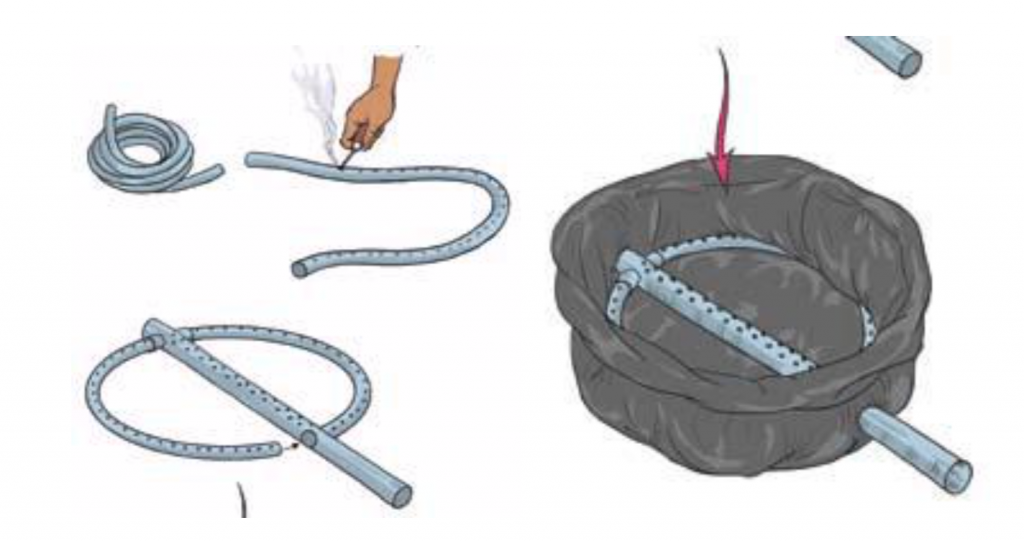
- Step 3Pass the rubber tubing through the top holes in the drainage pipe, so that the open ends of the tubing align at the bottom of the pipe as shown in Figure 5.

Step 4
To make a good seal at the bottom of the silage tubing, first open up the tubing. Then on one open end (that will be the bottom of the tube), make even pleats about 20 cm long starting from the end towards the centre on each side of the tubing. Then twist the pleats together and tie off with the rope making a strong knot. Then turn the tubing inside out, so that the tied knot is on the inside (Figure 6).

Step 5
Make a 3.5 cm diameter hole using a knife at the side of the tube, about 43 cm from the tied knot. Then take the joined drainage pipe and rubber tubing and fit it into the inside of the silage tubing so that the bottom of the drainage pipe goes through the newly made hole, extending about 20 cm beyond the hole. Using the twine, tighten the plastic around the drainage pipe as shown in Figure 7.
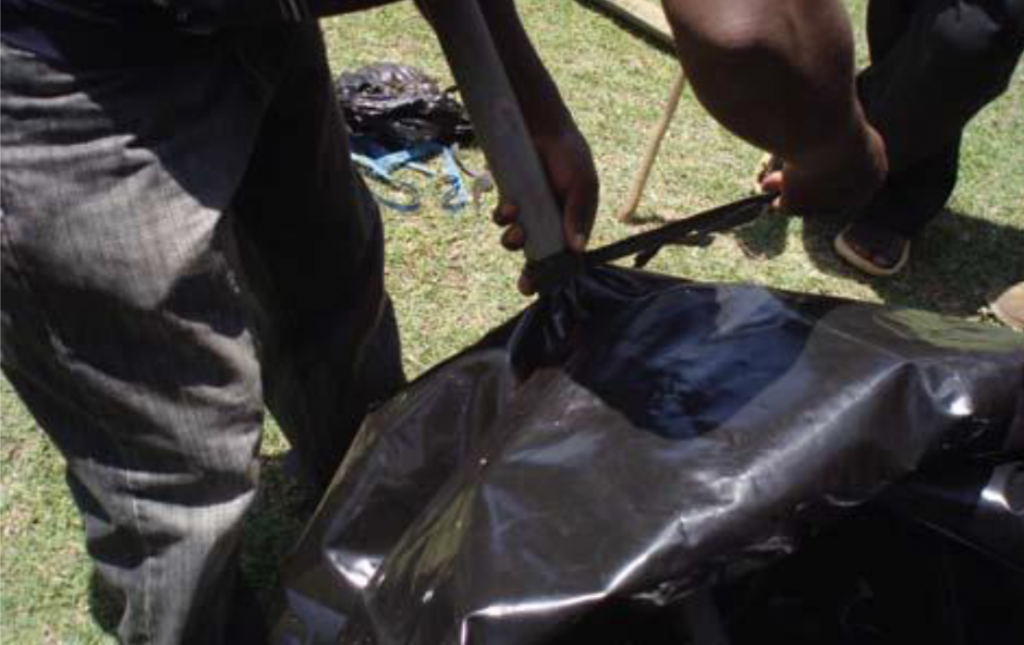
Step 6
Figure 7: Making the external drainage system of the silage tube
Fit a plastic tap or a piece of soft wood to the bottom of the exposed drainage pipe so that no effluent can flow out when the tap is turned off.
Step 7
To make a compacting drum measuring 86 cm in diameter and 120 cm in height first remove the top and bottom of each drum to make it hollow. Look for a shaded place to make and store the silage. Then cut each oil drum on one side, so that when joined the total diameter matches that of the silage tubing. To join the 2 drums together running lengthwise, have a welder make on each side 3 joints and one 75 cm long rod bent on one end to fit through the joints as shown in Figure 8.
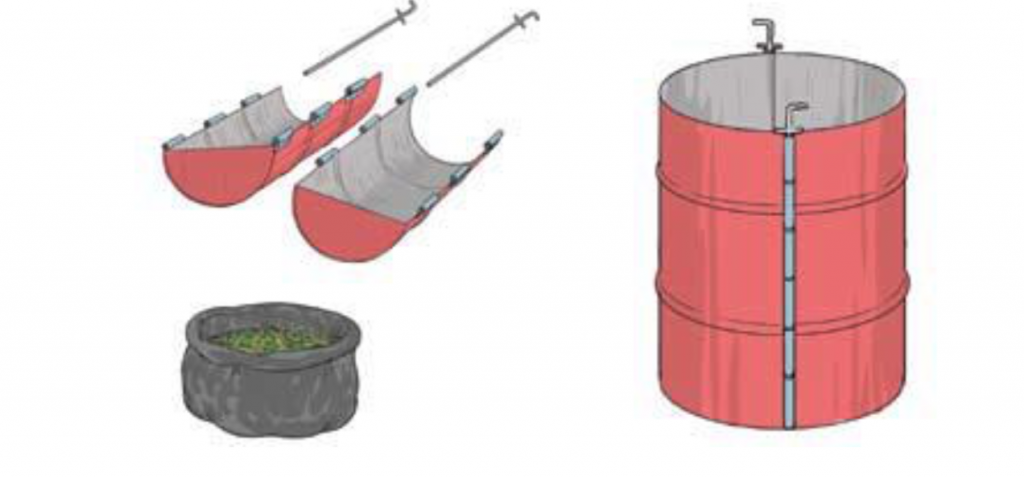
Step 8
Place the silage tubing inside the closed compacting drum, letting the excess tubing fold over the sides of the drum at the top. Ideally, the diameter of the tubing should be the same as or slightly larger than the drum for best results (Figure 9).
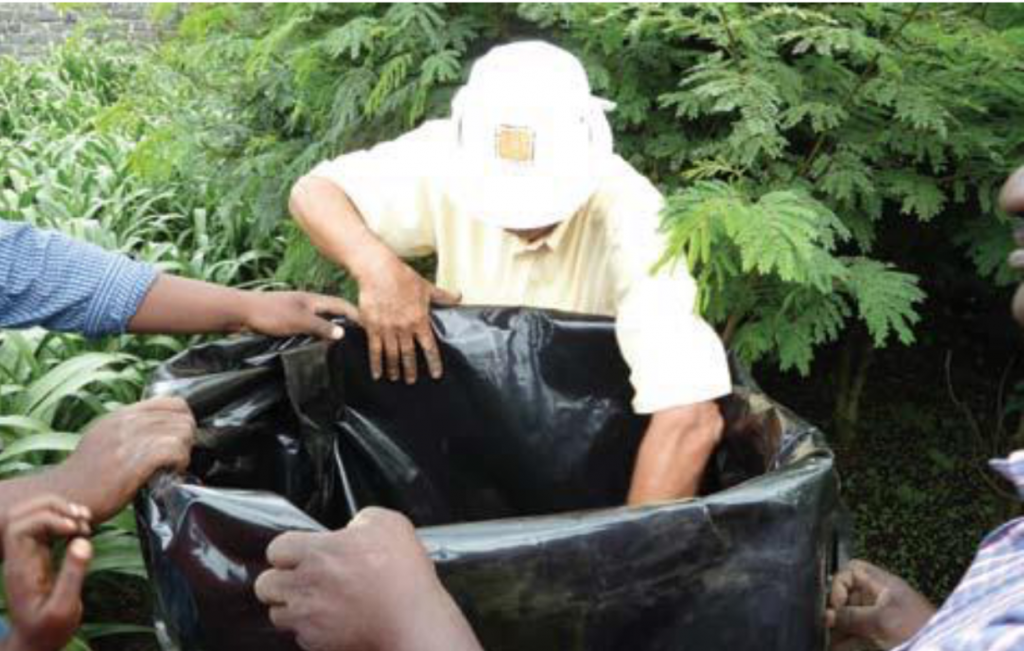
Step 9
To prepare the material for ensiling, chop the sweetpotato vines and roots to be ensiled into pieces not more than 2.5 cm long (Figure 10). A motorized chopper can be used


Step 10
Prepare the molasses and water mixture by mixing 8 kg of molasses with 2 to 3 times as much water until the mixture can flow easily (Figure 11).
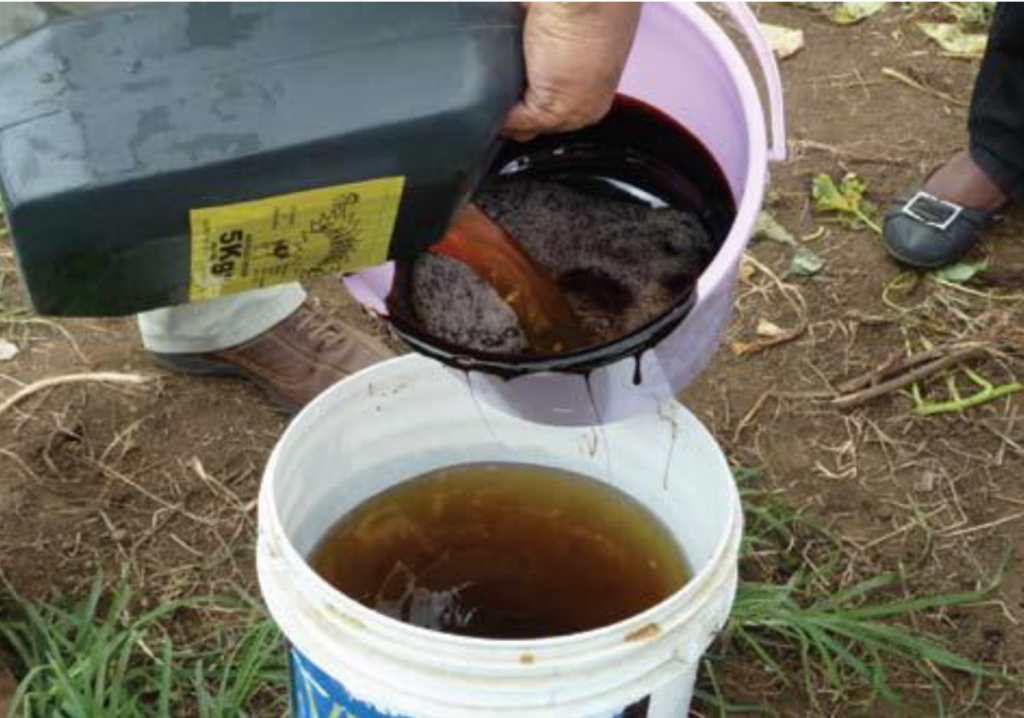
Step 11
Figure 11: Preparing molasses
Fill the tubing with alternate layers of the chopped vines and roots and the molasses/water mixture. Each layer of vines and roots should be 20 to 30 cm high; then sprinkled with the molasses mixture until it is thoroughly wet on top. Each layer must be compacted before adding the next layer. One person can compact using feet as shown in Figure 12.

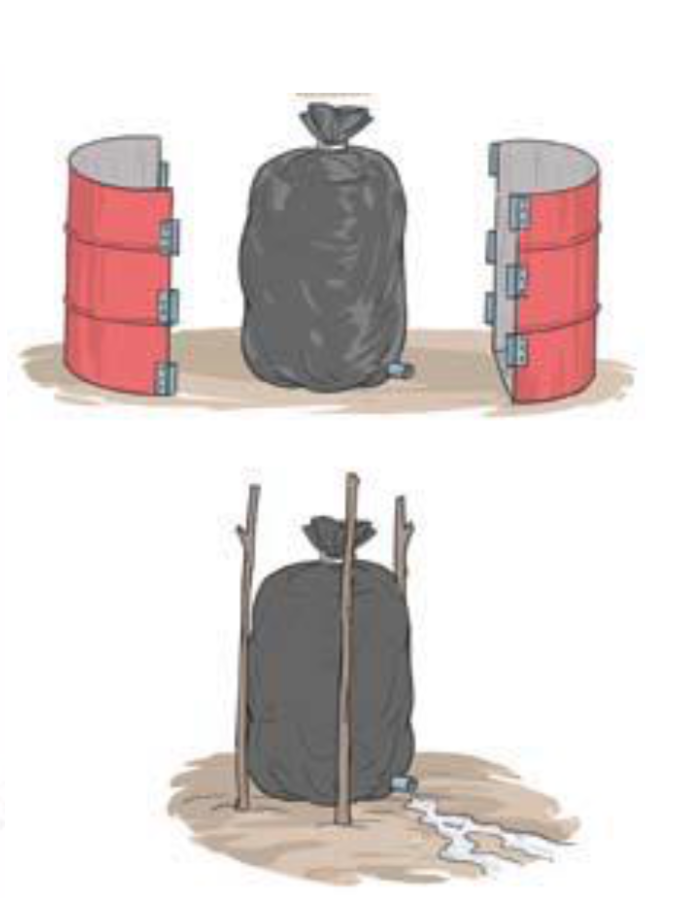
Step 12
Bunch the excess tubing at the top together, remove all excess air so the plastic is in touch with the ensiled material and tie a tight knot, using the twine. Place heavy stones on top of the silo to ensure continued compaction during fermentation (Figure 13).

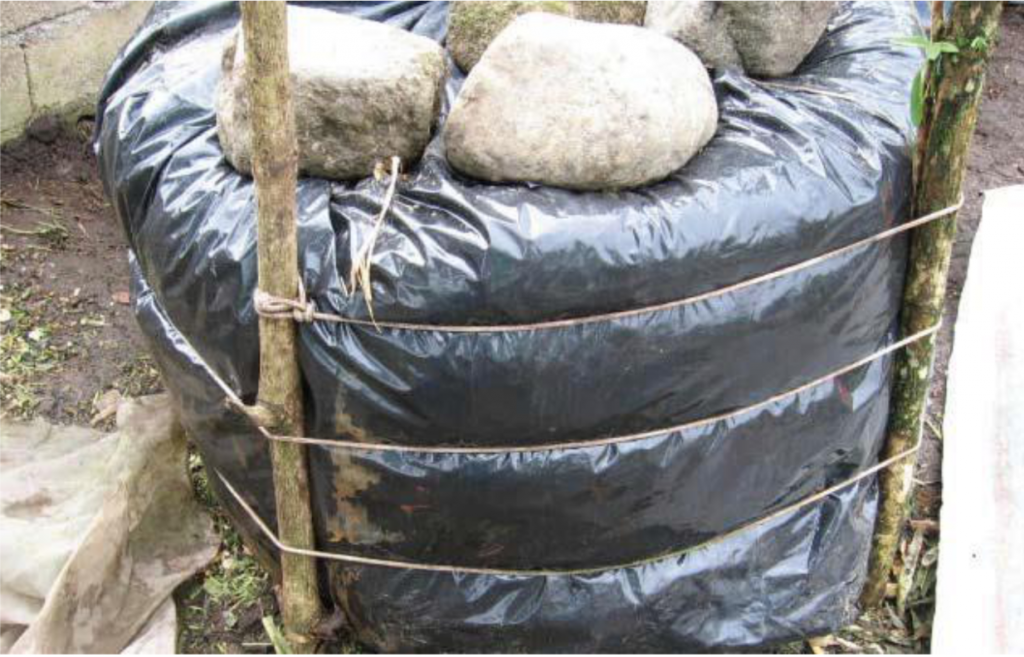
Step 14
For the first five days, open the drainage tap daily and leave open until all the effluent comes out, then close (Figure 15). Then open the tap every 4 to 5 days thereafter and let any effluent come out. Fermentation is usually complete after 30 days.
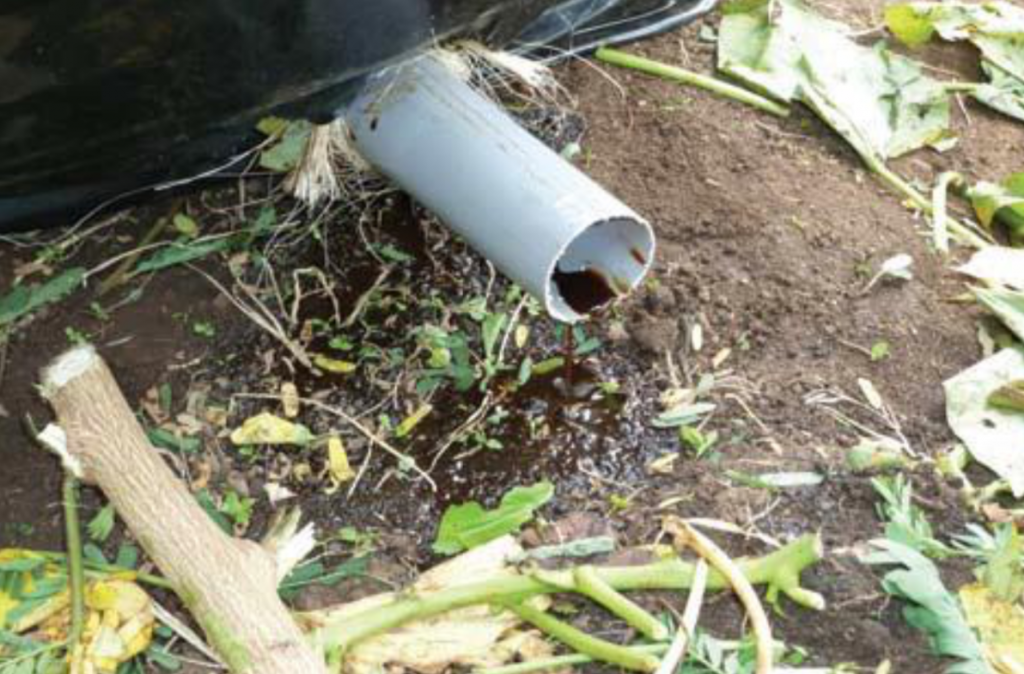
How do you know silage of good quality?
Well-prepared sweetpotato silage is bright or light yellow-green in color, has a strong smell similar to that of fermented milk and has a firm texture. Poor quality silage tends to smell similar to rancid butter or ammonia. Sweetpotato tube silage should be stored under shade, for example in a store. Rodents like rats that could tear the tube need to be controlled. When feeding, open the tube and after removing the amount needed, remember to re-tie without trapping air inside.
How much does it cost to make sweet potato silage?
One tube holds about 250 kg chopped, well compacted silage. An example of the average cost of making one sweetpotato silage tube is indicated in Table 7.
Table 7:
| Material | Quant | Unit cost (UGX) | Total Cost (UGX) |
| Fuel and oil for chopper | 0.5 | 5,000 | 2,500 |
| 1000-gauge polythene tube (meters) | 2.5 | 6,000 | 15,000 |
| Chopping and ensiling process (labour) | 1 | 20,000 | 20,000 |
| Molasses (litres) | 8 | 2,000 | 16,000 |
| Cost of making the drum and the drainage pipes(one off cost as can be used multiple times) | 1 | 180,000 | 180,000 |
| Total cost of making one tube of silage (excluding the drum and the materials used to make the drum) | 53,000 |
Estimated cost of making 1 kg of silage: UGX 214 (full costing of the polythene tube included. However, if carefully used it is possible to reuse the polythene tube up to 4 times, thus reducing the cost of making silage).\
FEEDING SILAGE TO LIVESTOCK
Silage is ready for feeding at least 30 days after making it. Silage should be fed as soon as possible, preferably within a few hours after opening the silos. After feeding, the feed troughs must be cleaned out to prevent any remaining silage, which will spoil, contaminating the next feed out. Silage can be provided to animals in number of different recipes based on its composition and the breed and use of the animals. In general silage should be used up to 25 kg per day for 550 kg animal and up to 5 kg for sheep, pigs and goats (Table 8).
| Stock | Quantity (kg/day) |
| Lactating dairy cow | 10-20 |
| Dry cows | 10-15 |
| Dairy Heifers | 5-8 |
| Beef breeding cows | 12-20 |
| Pigs (Sows) | 2-5 |
Table 8: Utilization of silage for different types of stock
Acknowledgements
Technical and financial support from: International Sweetpotato Centre (CIP); International Livestock Research Institute (ILRI); National Agricultural Research Organization; (NARO) National Livestock Resources Research Institute (NaLIRRI) and Kenya Agricultural and Livestock Research (KALRO) Organization